DIY Loudspeakers: HOME INDEX UPDATES RESPONSE WHAT'S NEW
EAR 861 Power Amplifier
Copyright 2017-24 © Troels Gravesen
go to: EAR 861 2019

I've been
looking for a small high-quality tube amp for my workshop, meant to
operate with my Hypex Ucd amp for
bi-amping.
As my Hypex amp is working fully balanced and has input attenuators,
something similar would be nice for amp supposed to run the
midrange-tweeter drivers. Now, having these demands really points to a
very few amps on the market except for PA amps, where these features are
common - and always solid state or digital. Not what I was after, rather
something like my GlowMaster.
Some EAR power amps have these features and being happy with my EAR-912
preamplifier I might give one of the power amps a try. Doing the usual
google study reveals quite a few positive reviews and I was lucky
finding a nice looking and "non-smoking" amp on eBay. I've bought used
gear before and given a current retail price of 7000+ EUR for a new amp,
which is a crazy price for 32 wpc, I took my chances - and was lucky.
The amp is like NOS despite being 11 years old. Based on the looks of
tubes and circuit board, this amp has had very little use and no need
for
tube replacements.
Later I was able to buy 2nd hand mint condition line stage, the
EAR-868L, which is a perfect partner for the EAR-861. The EAR-868L
has double balanced outputs and besides the usual SE inputs a single
pair of balanced inputs. The line stage itself is similar to the
EAR-912. And it has a remote! Just what I needed for my
workshop system.
Having had this system now for 1½ year (late 2018) I don't think I'll
ever get rid of these two components*.
*Actually I did replace the EAR-868L with a new
EAR-868PL.
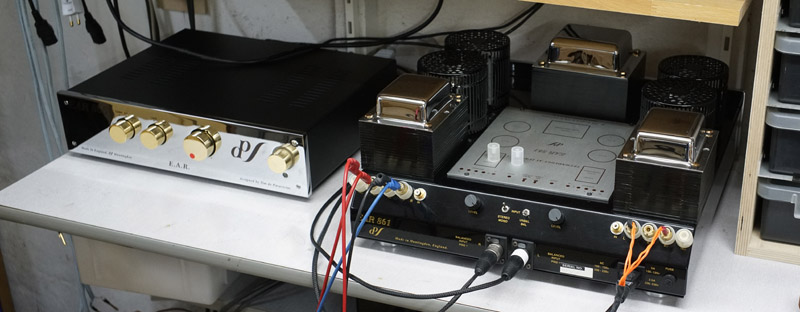
Here the EAR-861 description found at Needledoctor website:
Push-pull power amplifier operating in pure
Class A, enhanced triode mode. Zero overall negative feedback. 32 wpc
stereo (bridgeable to 64 watts mono) into 4, 8, or 16 ohms. Uses EL519
output tubes. Self-biasing. Balanced and unbalanced operation.
After years of research, development and day-to-day manufacture with the
EL519 series of pentode tubes, Tim de Paravicini has come up with a new
and exciting Triode configuration. Conventional triode connected
pentodes have the second grid tied to the anode, which results in a
halfway compromise between a pentode and a triode. This neither has the
efficiency of the pentode, nor the linearity of the triode. Tim de
Paravicini's Enhanced Triode Mode (ETM) goes one step further, and
creates a true, highly linear triode from a robust pentode tube.
Instead of driving the normal Grid One with signal, this is tied down to
the cathode, and thus becomes an invisible, transparent element, and
part of the cathode. Signal is fed into the tube's Grid Two, and in this
configuration, Grid Three has no effect - it can either be connected to
earth, or left floating. The ETM behaves like a true triode and is in
fact more linear than the majority of directly heated triodes. Compared
with the latter, it has the additional advantage of being a tough, more
robust tube, capable of much longer operational life.
The first amplifier to use the ETM configuration was the '859, and with
some justification the '861 could be regarded as a push-pull version of
the '859. However, this is more than a slight understatement: each
output transformer has a massive 5 kilogram weight, with no feedback
applied around it. The circuit is balanced push-pull from input to
output, allowing balanced (professional-style) inputs as well as
conventional unbalanced (RCA phono jack socket). Similar to the '859,
the circuit is direct-coupled. Tube choice is not critical; perfect
operation does not rely on matched tubes, nor on user adjustable bias.
Output power is 32 watts per channel, 20 Hz - 20,000 Hz. The half power
bandwidth is in excess of 16 Hz - 60,000 Hz, both with low total
distortion, and no overall feedback. Tube complement: 2 x ECC83, 6 x
PCC88 and 4 x EL519. Amplifier weight: 27 kilograms.
Subjectively the amplifier has the same 'family' sound as the EAR 859.
Listeners will find it builds heavily upon this, with an increase in
authority and attack. The lower bass has real grip and feel with this
amplifier, way in excess of the 32 watt power rating while the treble is
smoother, cleaner and sweeter, mainly due to the lack of overall
feedback. A single word can sum up the 861: ''effortless.'' It has real
power and control, the power to convey the emotion of the most demanding
of recordings, whether the source be our preferred analogue or digital.
First thing I did was measuring the gain of the power amp to be able to
align the gain of my Hypex modules of the ATS4-HE speakers. I cannot
understand why manufacturers are so reluctant to state the gain of their
products. So much needed.
The measurements here were done on the 8 Ohm taps and with an 8.2 Ohm resistor across terminals. 24.6 dB average gain is excellent. Only need to tune down the Hypex modules by 1.5 dB. So done, overall low-end balance is perfect.
I didn't expect the EAR 861 to be a sonically fully compatible with the
GlowMaster, but it turned out not to be that simple. The GlowMaster had an edge in far field
ambience and overall resolution of dynamic complex material and maybe
we're down to the difference in power, where the GM excels in dynamic
head-room. It does have twice the power of the 861.
This 861 amp is kind of "annoying" as my standard tweaking tool-box
seems to run short. I mean, orange-drop polyester coupling caps against
VCap CuFT... Which points to the fact that there are more to tube amps
than just a couple of coupling caps. The 861 does have an enticing
ability to bring us close to the music and let us forget about subtle
details.
What stands is a magnificent sounding power amp with more than enough
power to run the mid-tweeter of the ATS4-HE and similar constructions, thus an ideal partner for
bi-amping*.
After a few weeks of use with a variety of speakers I've come to like
this amp even more. What strikes me the most is its ability to drive
low-efficient, 4 Ohm speakers from its 8 Ohms taps. For some reason it
doesn't sound as good from the 4 Ohms taps.
It's simply amazing the drive and punch this amp can deliver**.
Only flaw I can point to is the inscription on the top plate:
"TECHNOLOGY AT IT'S BEST!". First of all you don't put an exclamation
point on an amplifier! And the error of using an apostrophe in "IT'S" is
hard to believe from an English product. Had it been Chinese... Even with my limited
English skills it should be "ITS". I guess EAR have had hundreds of
these made as it is found on several amplifiers. Bottom line is you
don't have to brag about an amplifier like this. I know, "it ain't
bragging if it ain't lying", as Americans would say, but still...Given the current 861
retail price it's like Rolex adding "TIME AT ITS BEST" on their 10 kUSD
watches. Bad taste!
*: Replacing the coupling caps with Rike cupper foils
caps did the trick. Not an easy tweak due to size! See below. I don't
think this amp gets much better.
**: Having had the 861 for some months now I'm surprised over and over again on how this amp can run speakers like the Ekta mkII, the ATiRi and not least the most recent FUSION. None of these speakers are in what I reckon as high-efficiency speakers (92+ dB range). Well , the FUSION is around 89-90 dB and 861 runs the 12" bass driver with slam and firmness. Not like the Hypex Ucd400, but so close I ran the FUSION for long before I even considered bi-amping.
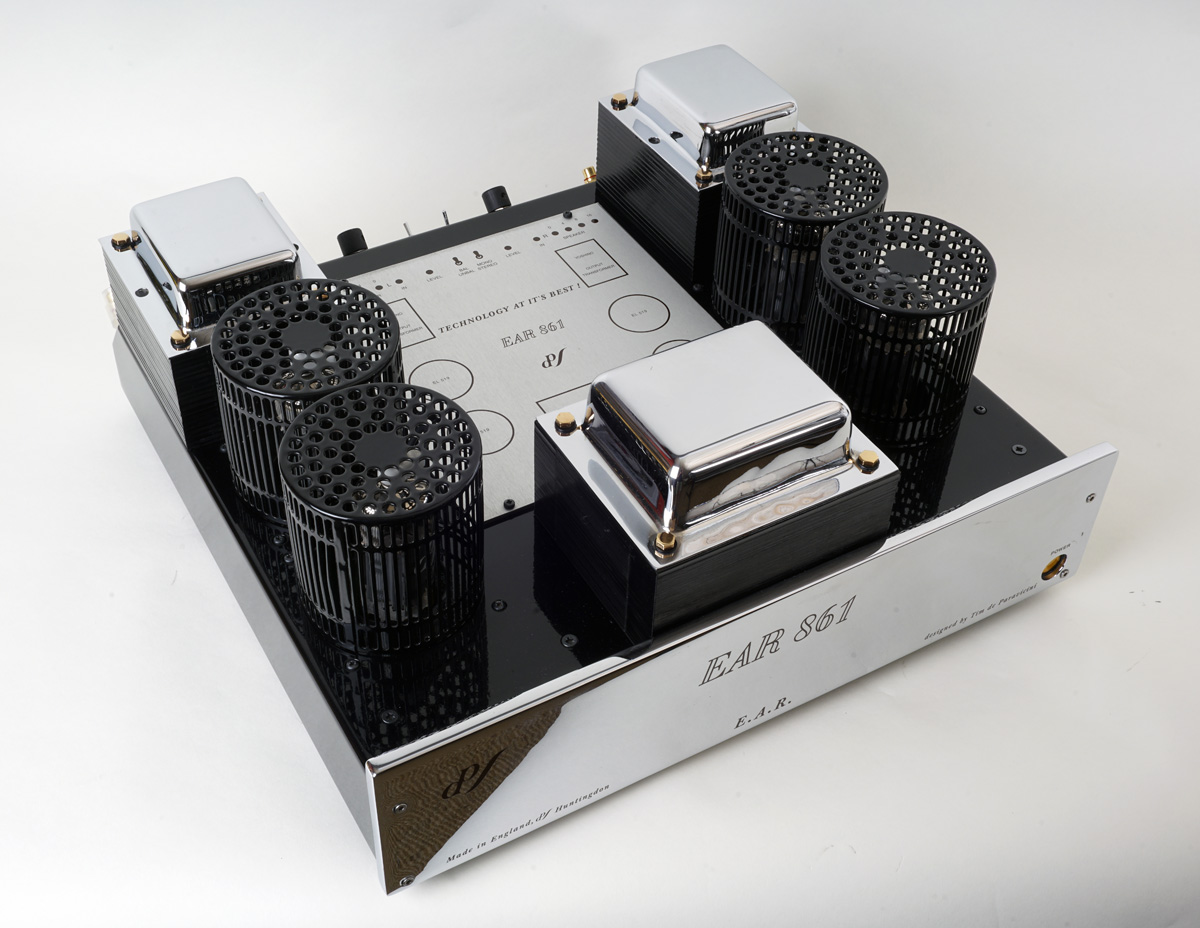
In Danish we have the word "rør-slæde", which means tube-sleigh. This is
what
it is.
Beauty is in the eye of the beholder, but I love the design of
the EAR 861.
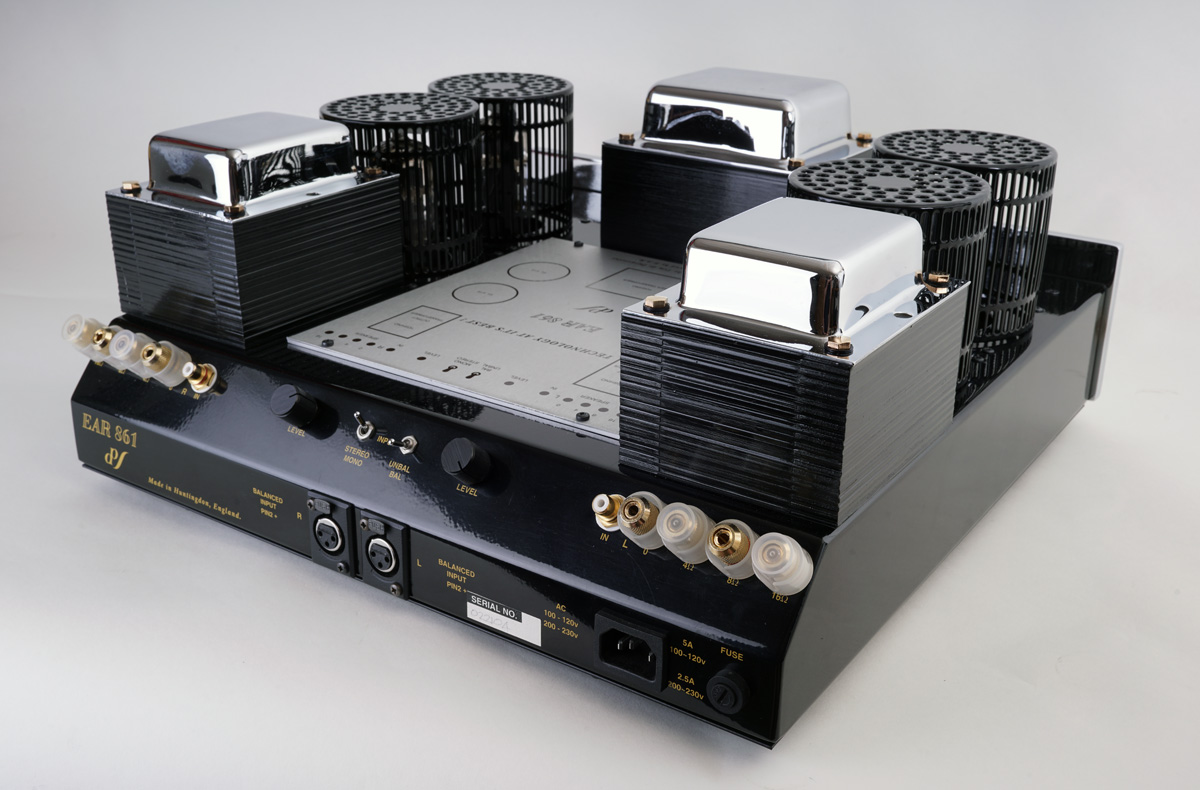
I use the amp on its 8 Ohm tabs, even for 4 Ohm speakers like the
SBA-MTM. By the way, a very good combination. I often have the
question from tube amp users which tab to use with a given speaker. The
answer is easy, you try out both and hear what sounds the best. There is
no right.
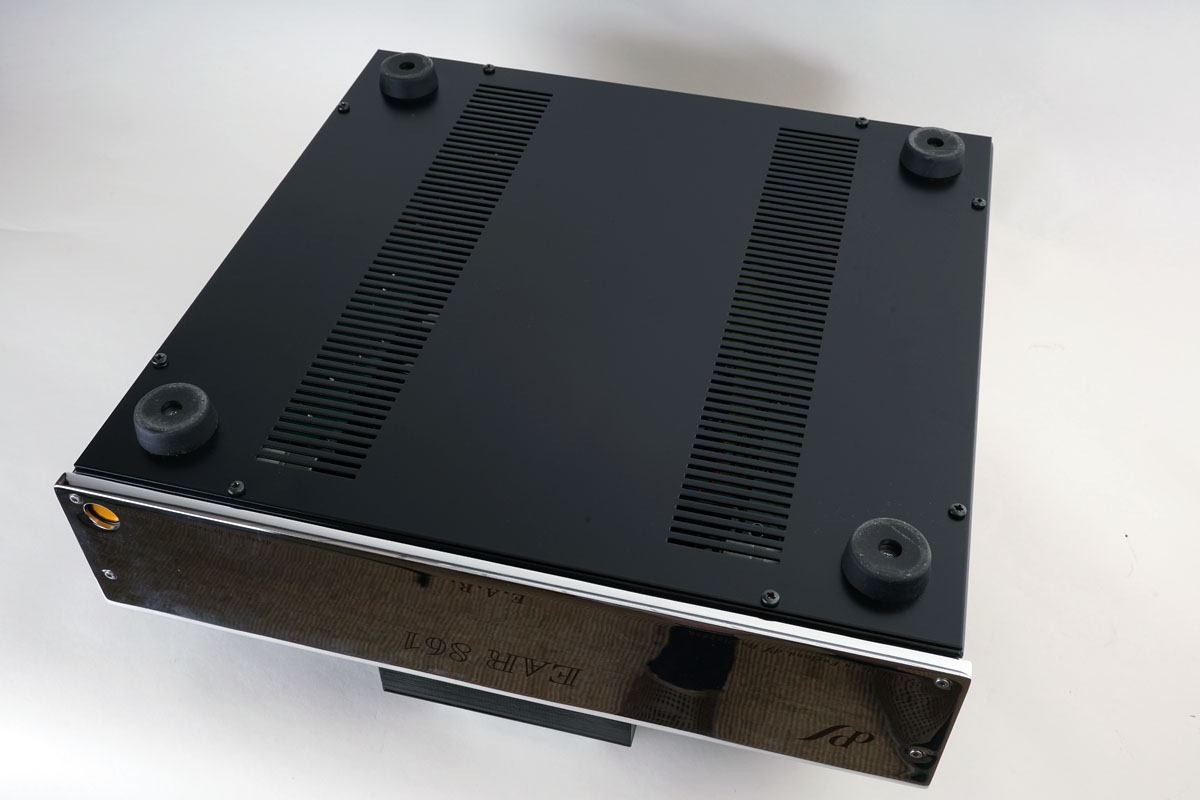
Rock-solid chassis from 2 mm steel plate.
I've added some new feet, 17 mm height, to be able to get my fingers
under it.
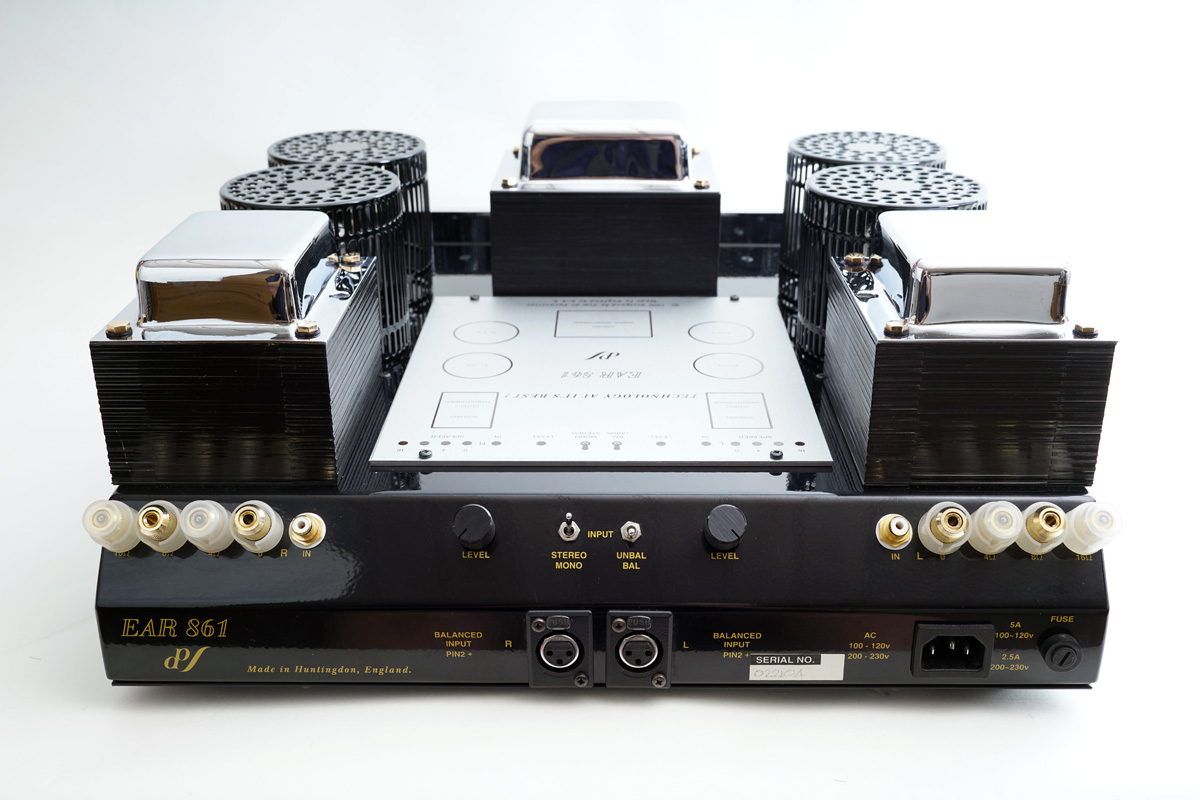
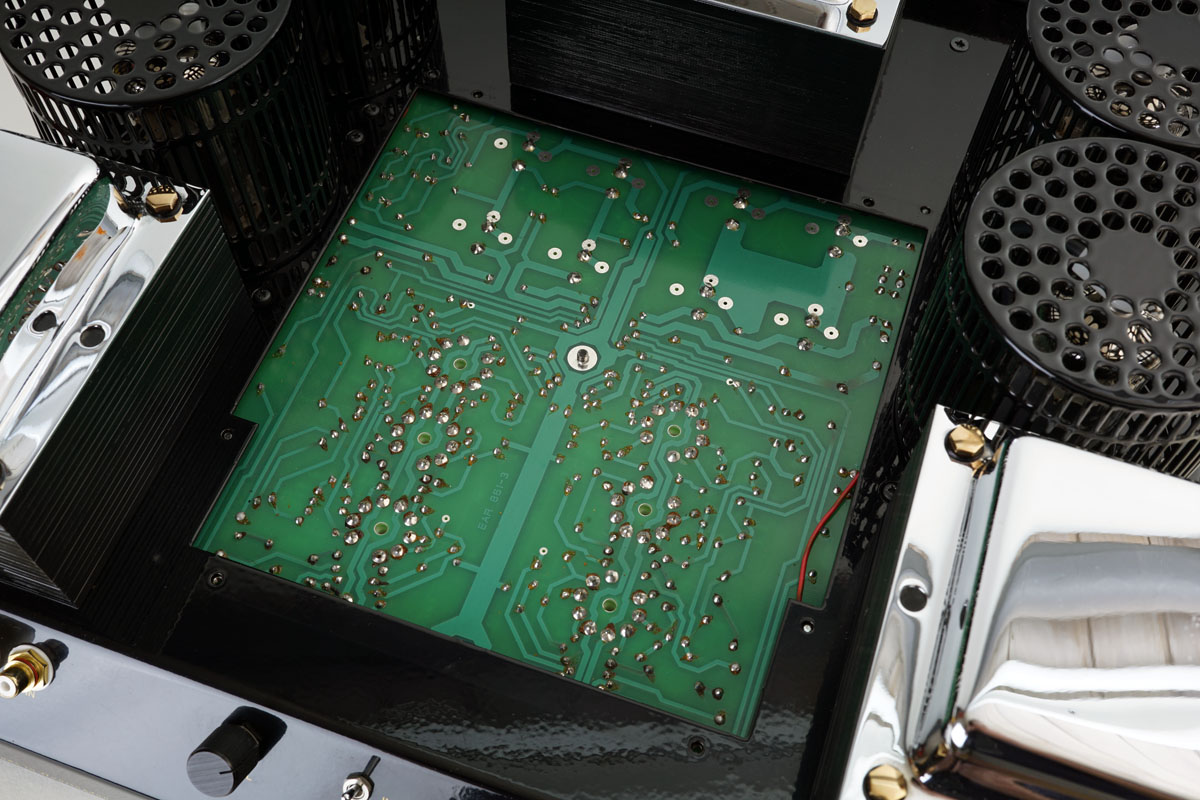
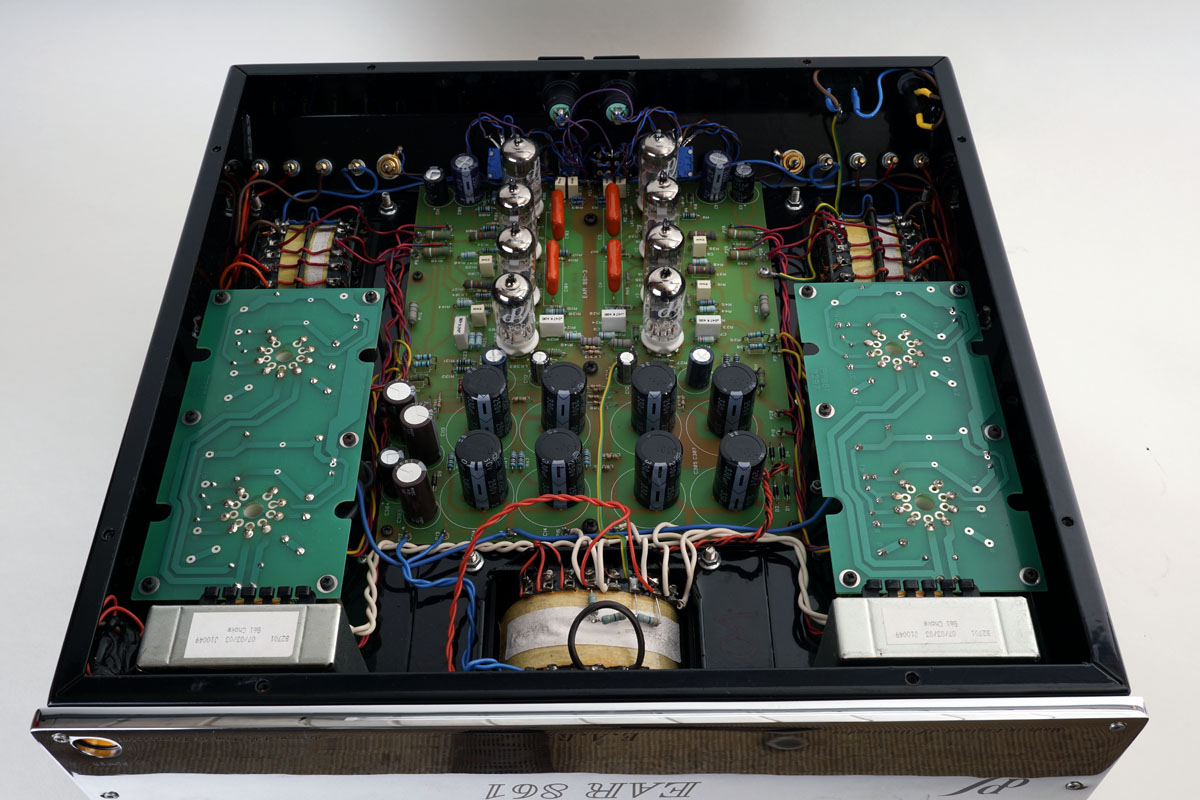
Click image above to view large
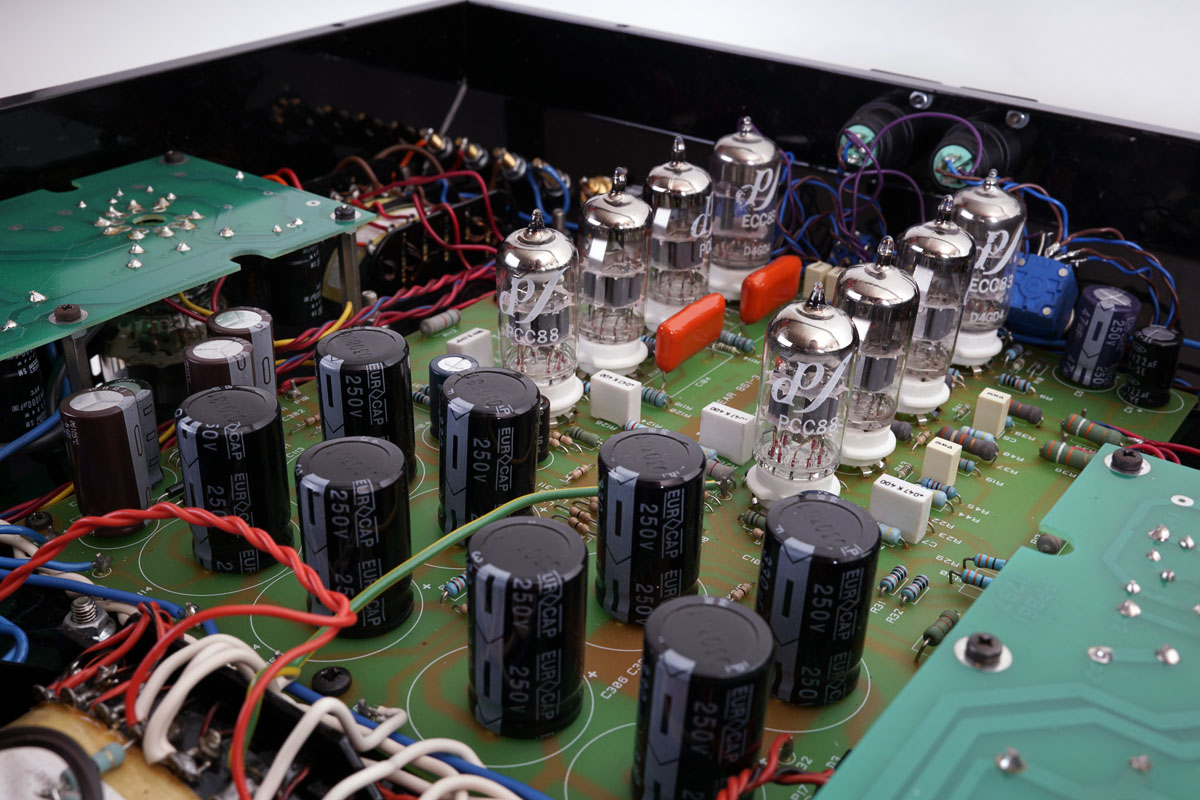
8 x 330 uF/250 volt capacitor bank.
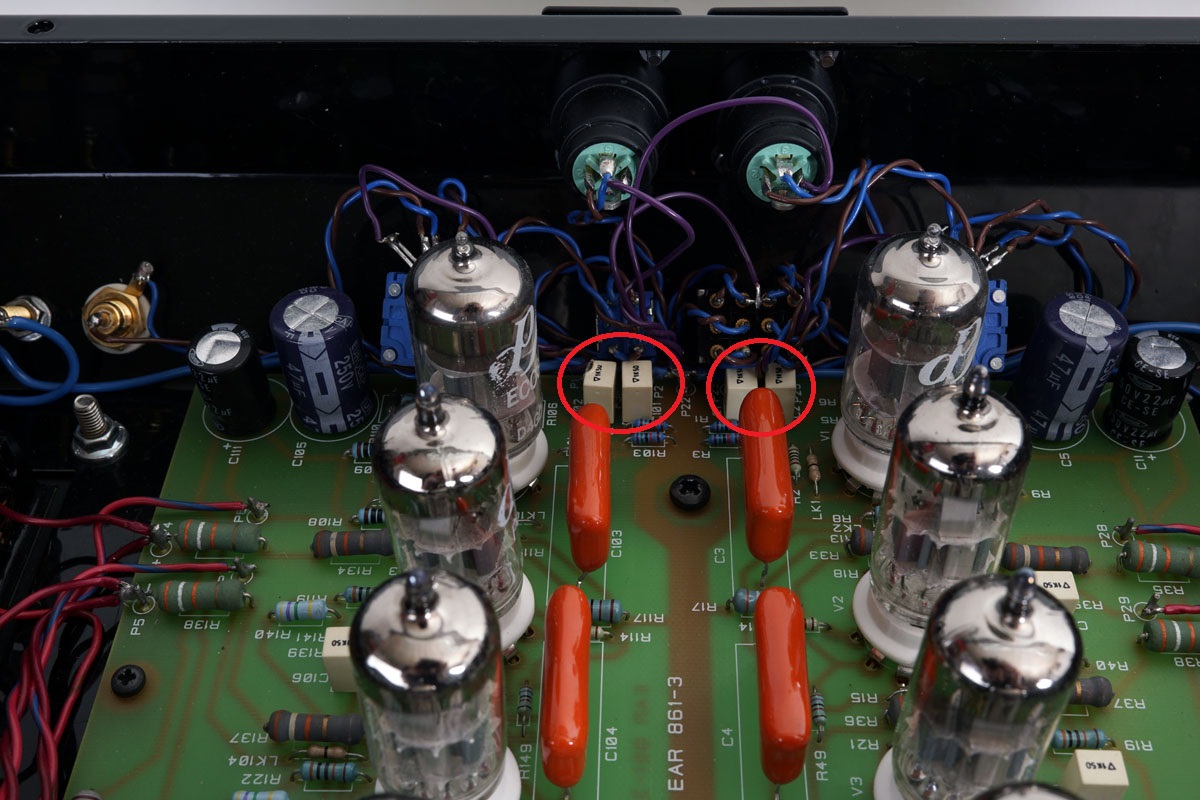
These orange capacitors are likely to be changed to some better ones,
but as-is, this amp sounds darn good. Actually tried inserting four
super-caps (double-lane metallised PP) - and surprisingly this
wasn't for the better, so the orange drops went back again.
The super-caps made a slightly aggressive top and no
apparent improvement in transparency. Hmm....
Having transformer coupled line stages I shorted the input caps (red
circles above). See schematics below. No need for potentially degrading
caps here. I fully understand EAR's concern for people having DC coupled
pre-amps. If something can go wrong, it will.
Another thing would be bypassing the input potentiometers and switches.
I tried shorting the potentiometers and it did not make any
change at all regardless of several recommendations. Most of the time
the amp runs with minimum attenuation and i reality the potentimeter is
just a contact point. I doesn't make any difference.
Analysing the schematics for possible bottlenecks can be hard. The
obvious coupling capacitors between amplification stages are the usual
suspects and possibly the 100k anode resistors, although I'm highly
skeptical about the latter. So, I made a cautious investment in four
0.68 uF Mundorf tin-foil capacitors - and then things finally started
moving in the right direction. Bass and mid as good as it gets, only the
treble range - despite being very smooth on the ear - leaves
some far-field ambience to be desired. Not much, but significant
compared to my GlowMaster. Next I by-passed the tin-foil with 10 nF
Silver/Mica caps from my former riaa-stage, and although I don't believe
this makes any difference, it sounds darn good! So, either the micas or
my brain i doing the job.
Next stage in testing is four Rika copper foils caps.

Now, these Rike caps are huge! Fortunately we have lots of space in the 861 and the solution was to add two bars next to the tube row and mount the caps as seen on photo. The caps I got from Rike were not the same "packing", which was kind of a disappointment, one pair was in tubes, the other with standard wrapping. Nevertheless, having the bar some 60 mm above the circuit board, there is just enough space for the caps, having a diameter of 50 mm! Length is 35 mm. This size caps doesn't allow placement between the valves.
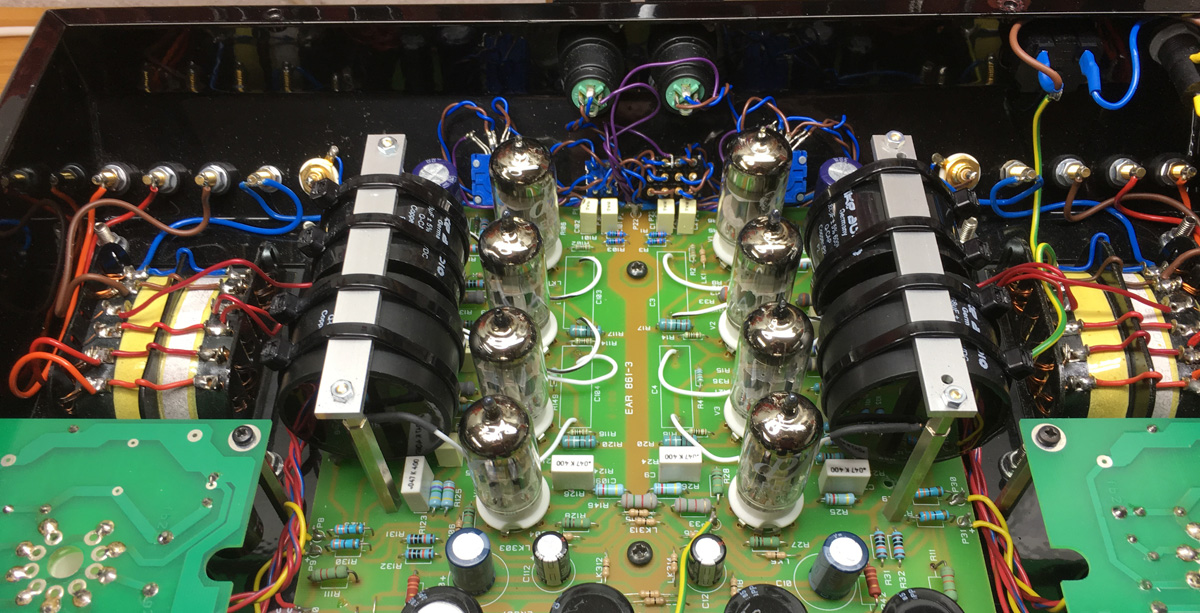
These Rike caps are a serious alternative to VCap CuFT caps and close to 25% of the CuFT. 238 EUR/four compared to 297 $/ea. What the Rike caps produce compared to tin-foil/silver-mica is the far-field ambience I have from the GlowMaster. This doesn't mean the two amps sound exactly the same. The 861 has some triode character, slight midrange emphasis. There's nothing soft or tuby about the 861 sound. Clear transparent midrange and shimmering highs. The ability to run low-impedance speakers from the 8 Ohms taps is amazing! It runs my most recent Ekta mkII, ATiRi and FUSION speakers to loud levels without trouble or apparent distortion. Mission accomplished.
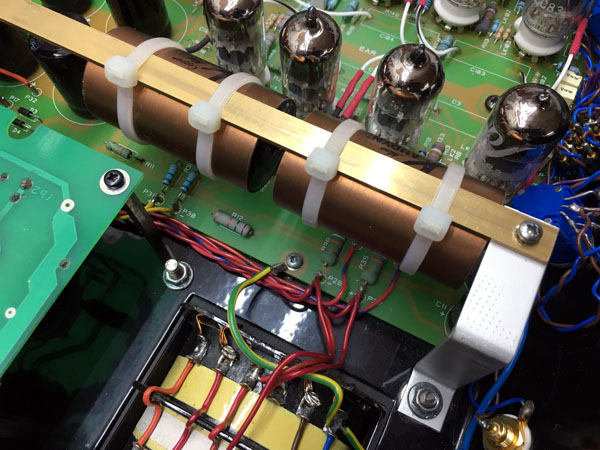
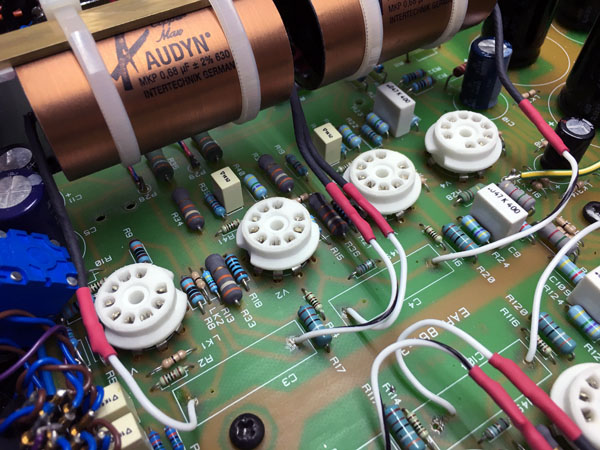
Above and below: Talking to an EAR guy at Munich it was also suggested
trying the Audyn Copper Max caps. So, 4 x 680 nF were bought at
HifiCollective, UK. Now, this time I would omit the support mounted on
the circuit board and made four brackets attached to the corner bolts of
the transformers. A brass bar was added and the caps secured by straps.
Actually looks a bit nicer than the Rike solution.
I can't say this sounds any different from the Rike caps, but they're
cheaper and are easier to implement - provided the support is made. The
Copper Max stays in. I don't see any reason experimenting any further on
this tweak.
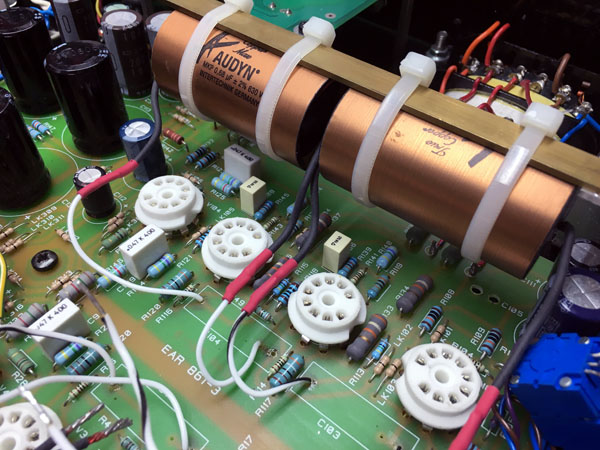
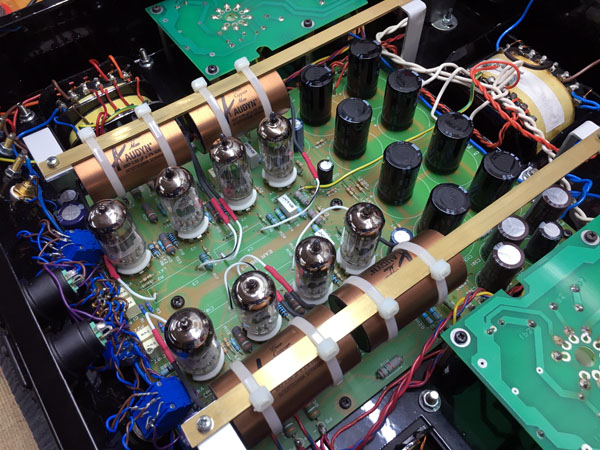
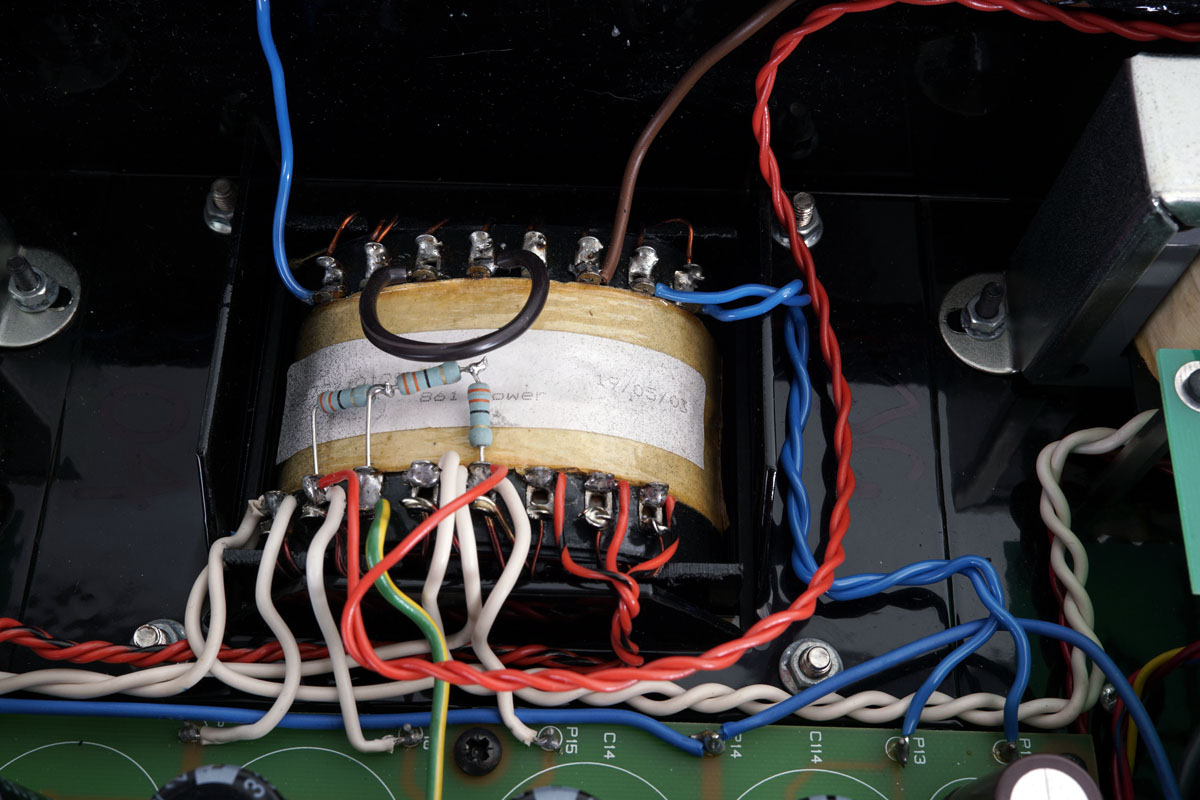
Power transformer.
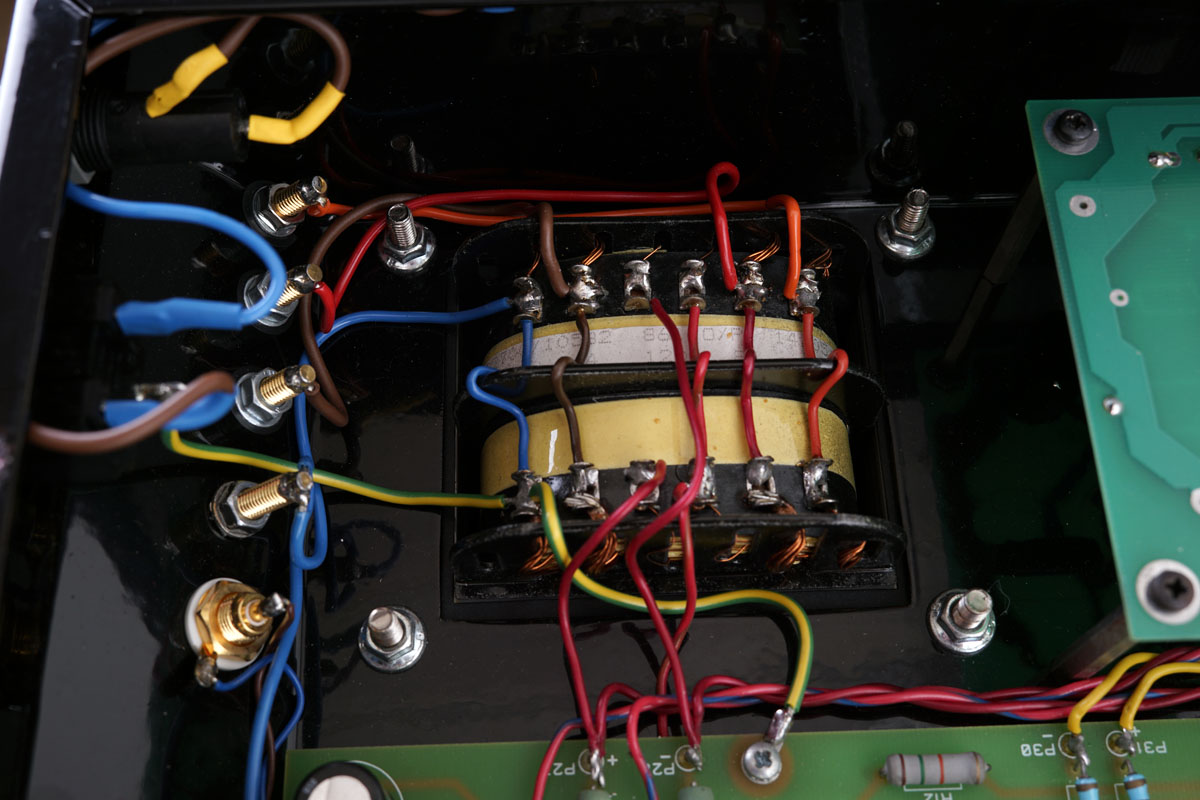
OPT.
Should you like the 861 so much you buy two, the amps can be bridged to make 64 watts.
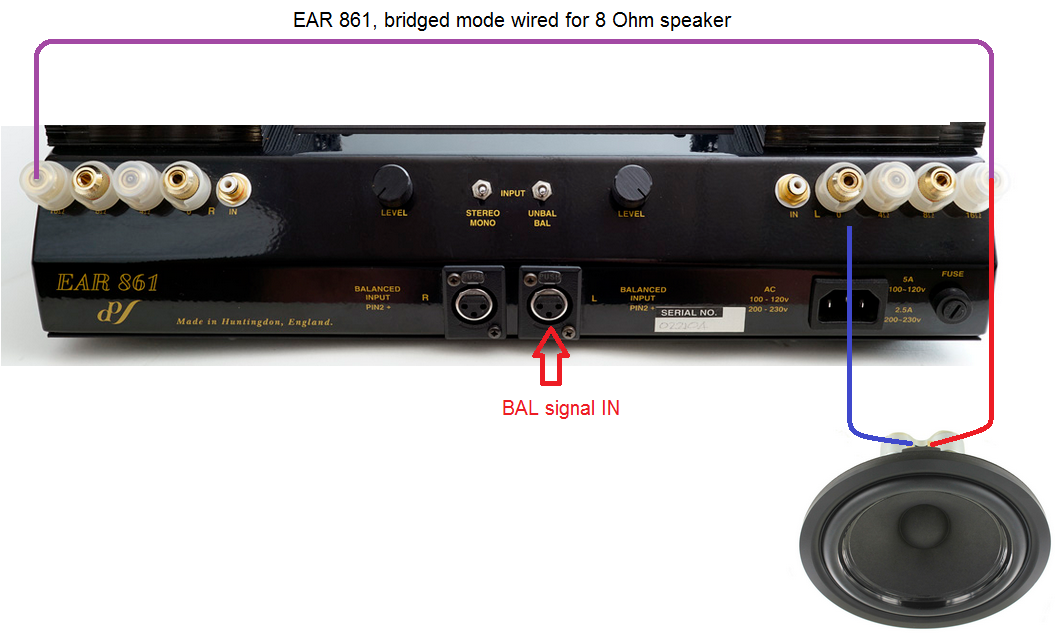
1. Connect BAL input cable to left channel.
2. Set mono/stereo switch to mono.
3. Turn left channel level fully clockwise.
4. For 8 Ohm speaker: Connect the two 16 Ohm tabs and connect speaker to
"0" and "16" Ohm tabs.
5. For 4 Ohm speaker: Connect the two 8 Ohm tabs with wire and connect
speaker to "0" and "8" tabs.
6. For 2 Ohm speaker: Connect the two 4 Ohm tabs with wire and connect
speaker to "0" and "4" Ohm tabs.
The manual includes these handwritten schematics.
This is not fully identical to the product I have, but it may
give an idea of how Tim Paravicini designed the 861.
Click image to view full-size.
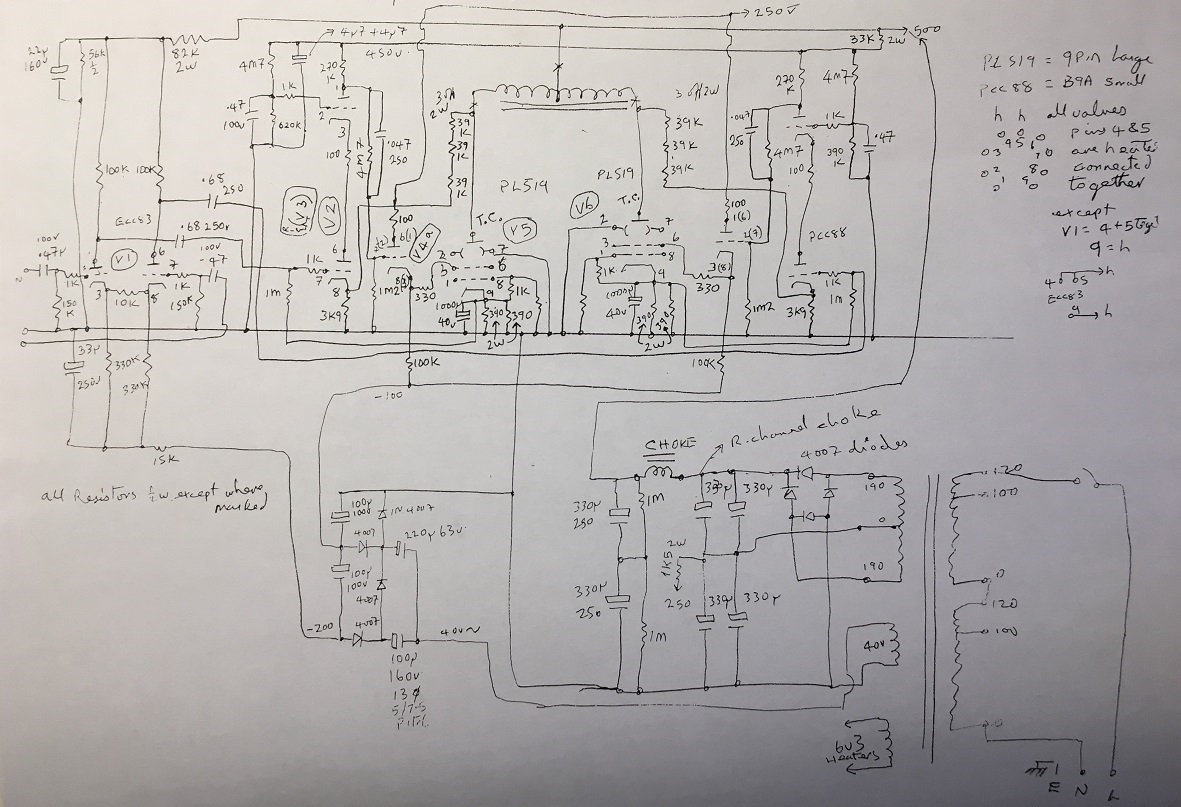
Schematics as found in manual. As mentioned above, the input capacitors
(0.47uF/100V) were by-passed . Actually they are 1 uF.
Also the driver stage appears significantly changed compared to this
simplified draft.
I've been more than pleased with my second-hand 2004 EAR 861 over the
last 2 years. It's reliable, quiet and has the neutrality - to my ears - and
transparency I was aiming at. Considering the price of two new EAR 861
amps I was thinking of alternatives like the
Nagra Classic Amp, which I've heard on several occasions in Munich,
and which impressed me very, very much. A totally different ballgame
going from PL519 tubes to a 100 wpc class AB solid state, but these
Nagra guys apparently know what they doing. Now, I can't have a Nagra
for testing in my living room. I don't even think there is such an amp
in Denmark. Would the Nagra give lower noise and transparency? Maybe
lower noise - after all - but the sound? Considering all the components
in my system, the EAR 861 is not the bottleneck except for power for
some low-efficiency speakers. It has everything I want, so why change?
Thus, two units were ordered in order to run them in bridged mode
making 2 x 64 watts - and my current reference speaker, the
Ellipticor-3s, with their
"sine-cap" 2.9 Ohms minimum impedance just love
it! Wiring the 861s in balanced mode for 4 Ohm just works fine (se above).
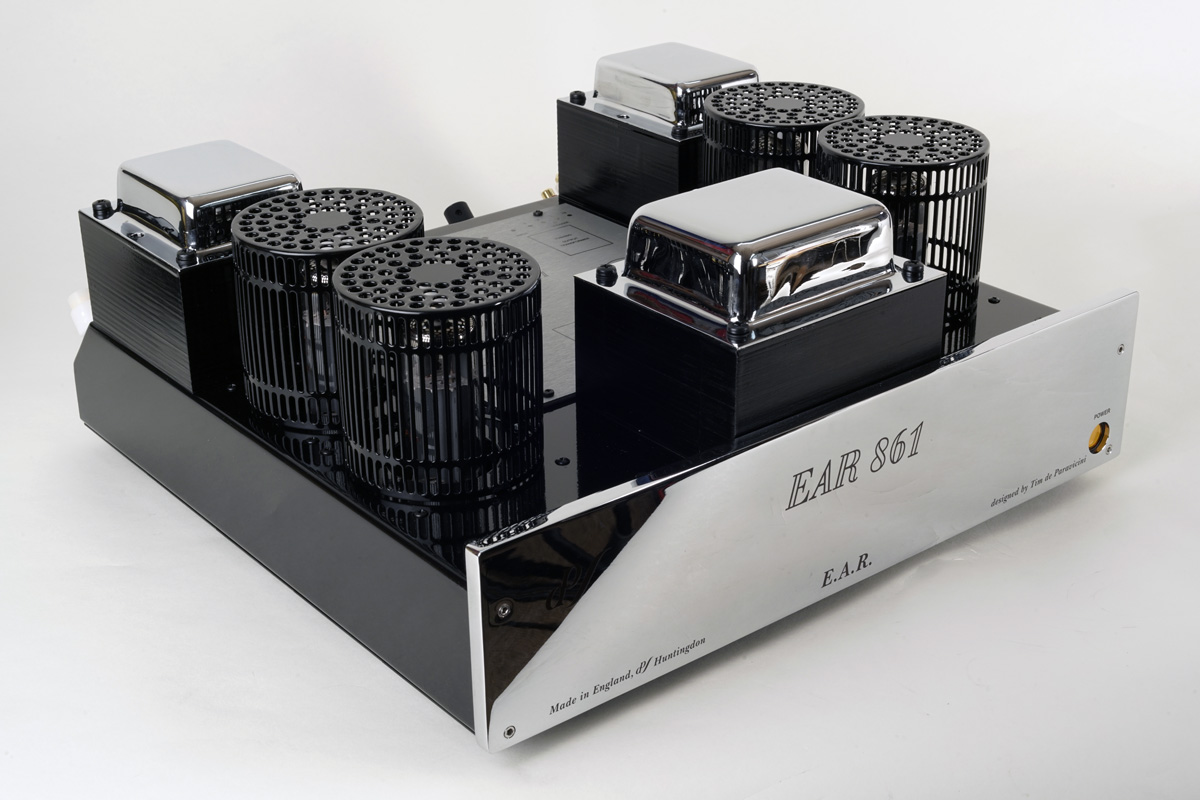
The new EAR 861 looks exactly the same as the 2004 unit I have.
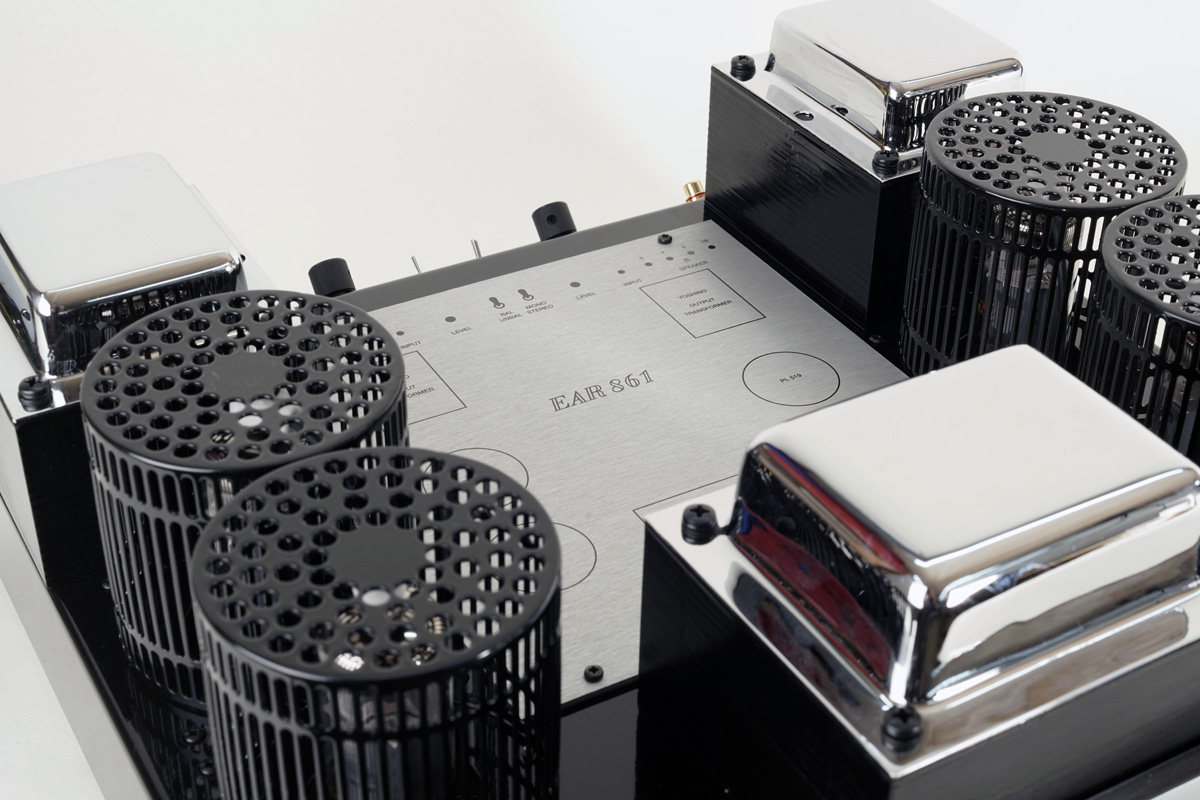
And yet, the silly - and misspelled - "Technology at it's best" has been
erased from the top plate! Nice! Thanks!
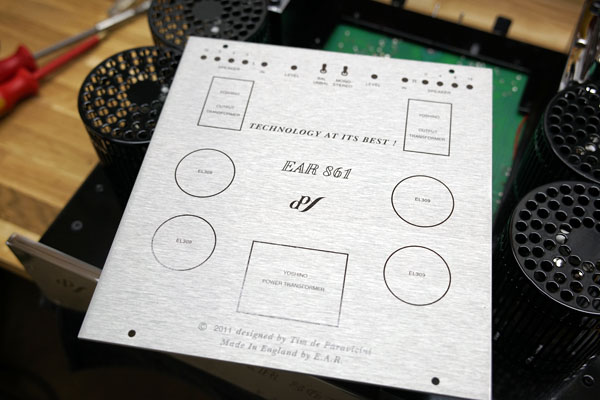
Removing the top plate and turning it around I found this: "TECHNOLOGY
AT ITS BEST".
Apparently EAR had the plates re-printed on the other side :-)
Maybe suitable for some markets... "It ain't bragging if it ain't
lying".
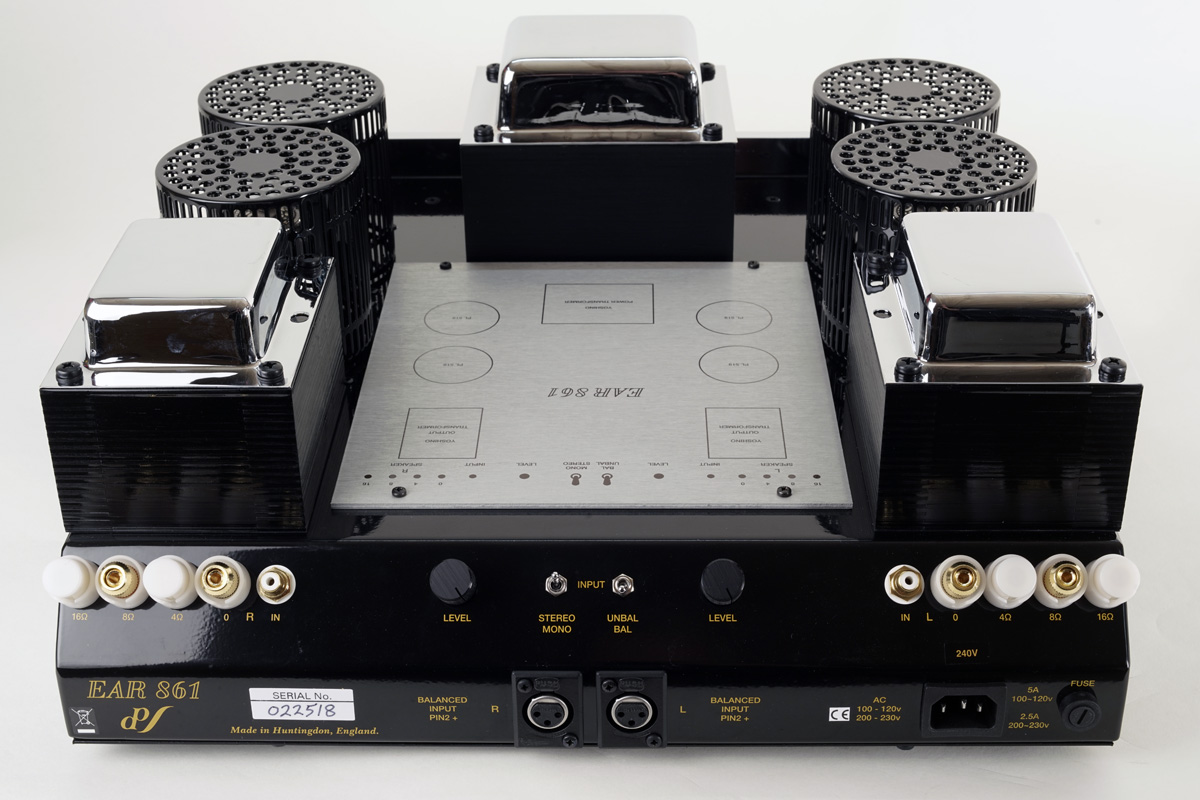
No change to the rear panel at all.
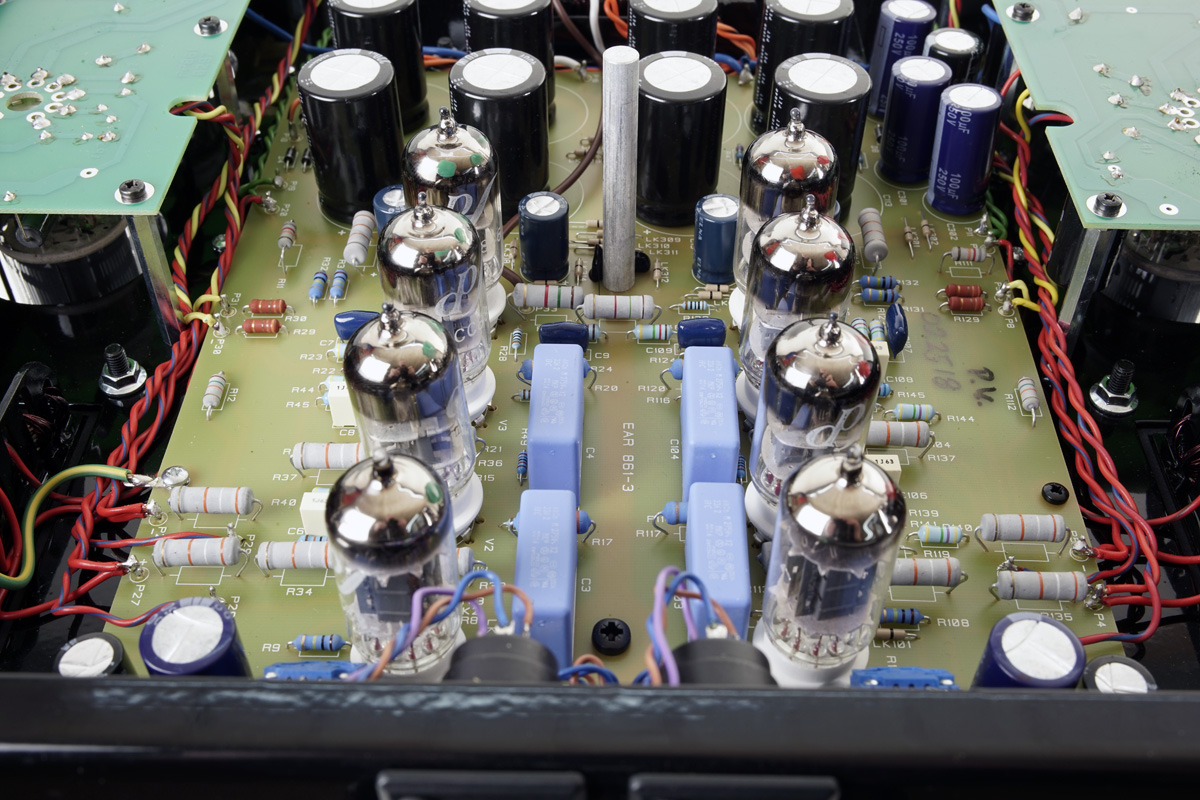
The el-cheapo polyester coupling caps have been replaced by some blue
polypropylene caps - and I think they sound better.
Setting up the new 861 next to my old - and modded - 861 made me a bit
uneasy as the difference really wasn't that big.
Time will tell if my by-passing the input capacitors and replacing these
blue PP caps with Miflex copper foil caps will take it even further.
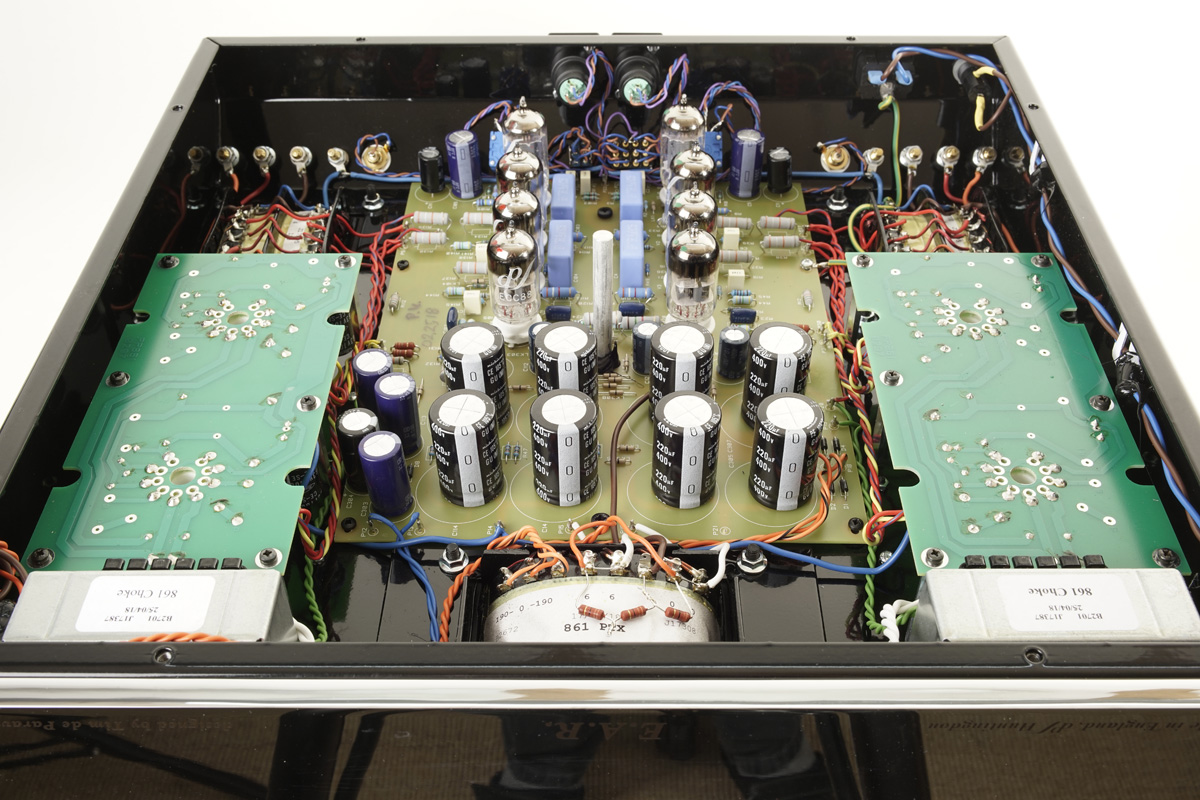
PSU bank of capacitors have been replaced by 220 uF/400 volts (the old
caps were 330 uF/250 volts).
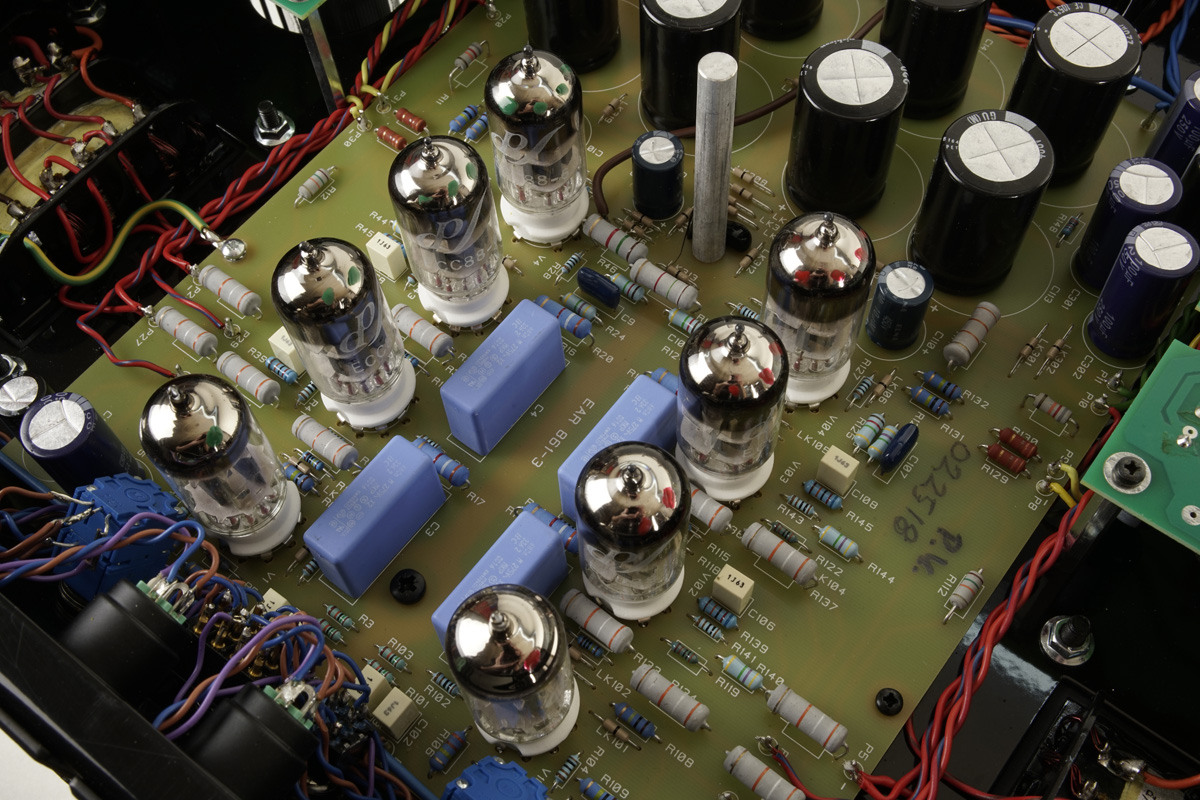
The circuit board has the same stock number as my 2004 version, EAR
861-3.
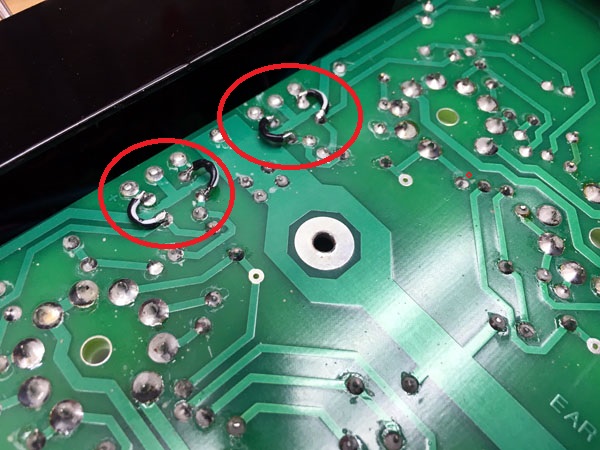
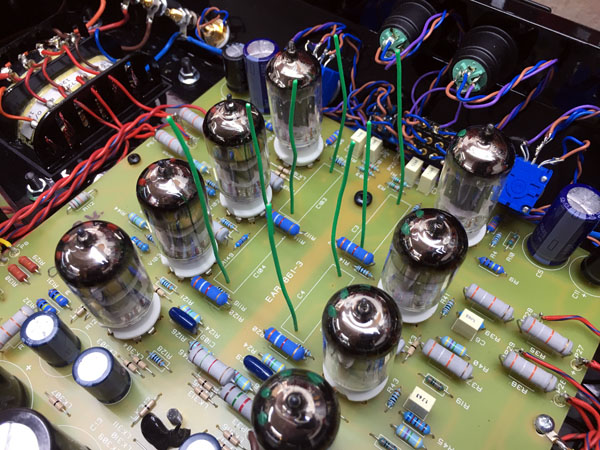
Left: Shorting the input capacitors with jumpers. If you do so, be
absolutely sure your line stage is AC coupled, not DC!
Right: Coupling caps removed and pieces of wire added for connecting new capacitors.
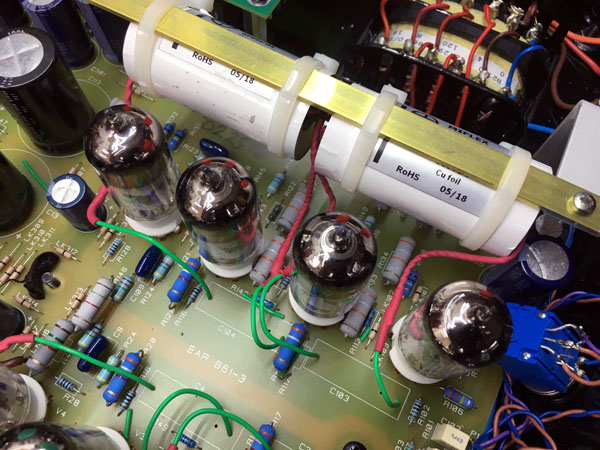

Here's the alu brackets made for the brass bar holding the caps. The
brackets are fastened to the corner screw of the transformers. The ones
placed at the PSU transformer is slightly shorter than those mounted on
OPTs.
New Miflex copper foil caps in place:
Miflex KFPM-01 Copper Foil Polypropylene Film Capacitors, 0.68 uF/600V
Around 135 £/four.
Dimensions for brackets. The brass bars are 260 mm length.
Intermezzo
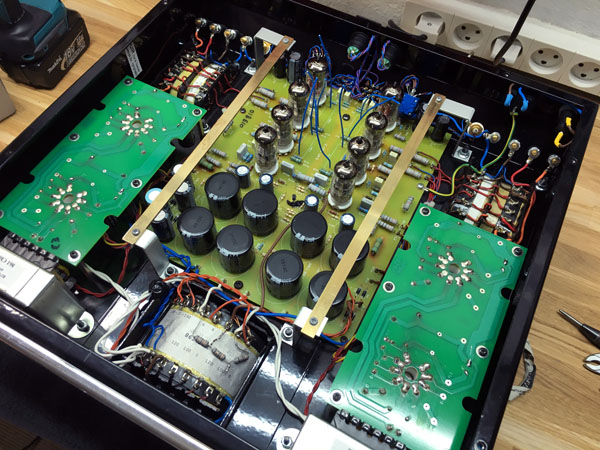
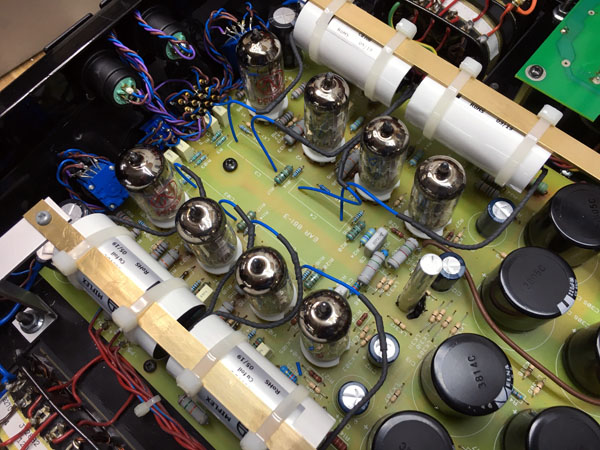
A friend brought his 2nd hand EAR-861 for a
capacitor up-grade and all went well until I turned up the volume on
some bass-heavy stuff and one channel started distorting seriously!
Damn! We went through all solder spots and any possible thing we might
have damaged and found nothing. Not knowing the true age of the amp or
tubes I did some more testing and at low volume everything went well but
when the amp had to deliver some amperes all went wrong. Hmm... These
TESLA output tubes did look kind of old so I changed them with a spare
set I have and now the amp could deliver the bass punch that is well
beyond what one can expect from 32 watts.
My friend had two sets of spare PL519 tubes with the purchase and we
changed the tubes and again - deep punchy bass. So, these PL509/519
can be too old. I never changed the tubes on my own 2nd hand -861
and these are the original PL519 with the TP logo. Considering its age,
my -861 really cannot have been used much. Now, the bad thing about this
experience is that my friend could not hear what the capacitor change
does to his sound at home as the output tubes most likely does more than
the change of capacitors. But he tells the sound is totally transformed
- for the better. He has my DTQWT speakers and given their sensitivity
was unlikely to notice the decline of the output tubes as they would
never require more than a single watt or so.
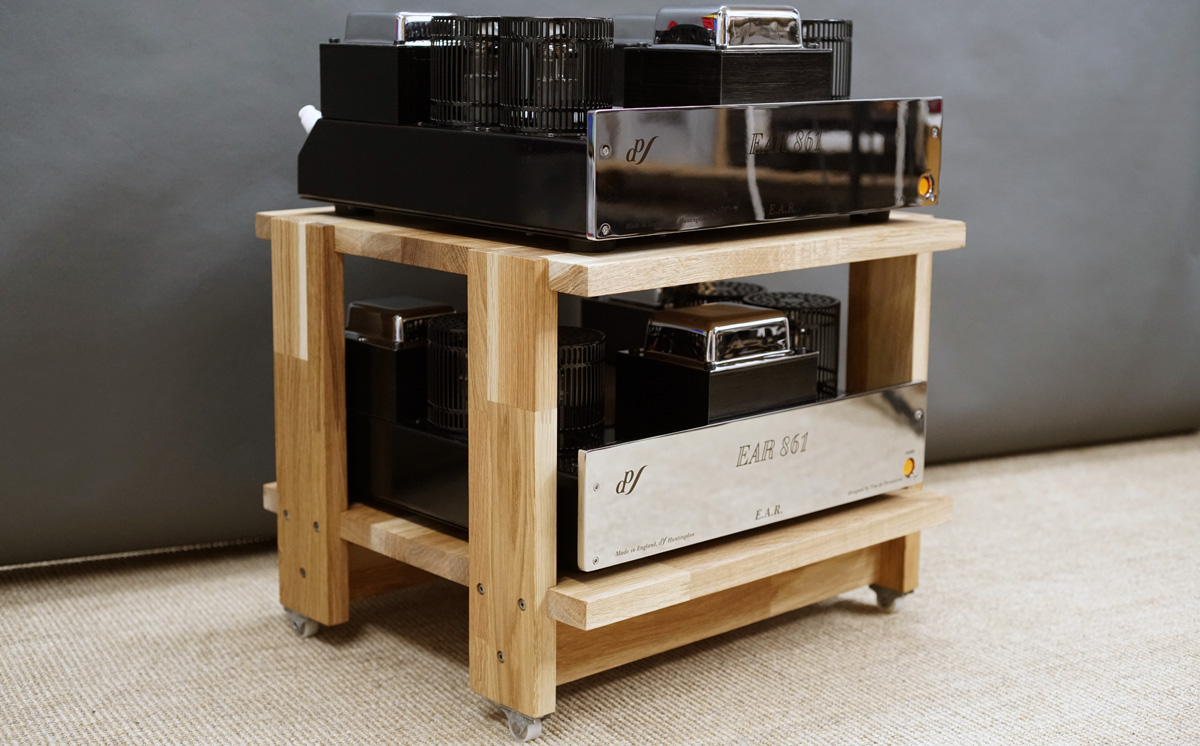
My 861 rack made from oak boards. Click image to view large.
I don't think the EAR 861 gets much better. Mission accomplished!
BTW:
My oldest EAR-861 eventually needed new output tubes and I had a PL519
quad from an eBay supplier. What came as a surprise was that my EAR-861
was fitted with EL519,
not PL519. EL519 runs
on a 6.3 volt heater where PL519 runs on 40 volts.
Fortunately the EAR-861 is prepared for this as the mains transformer
has both windings. Below you can see how.
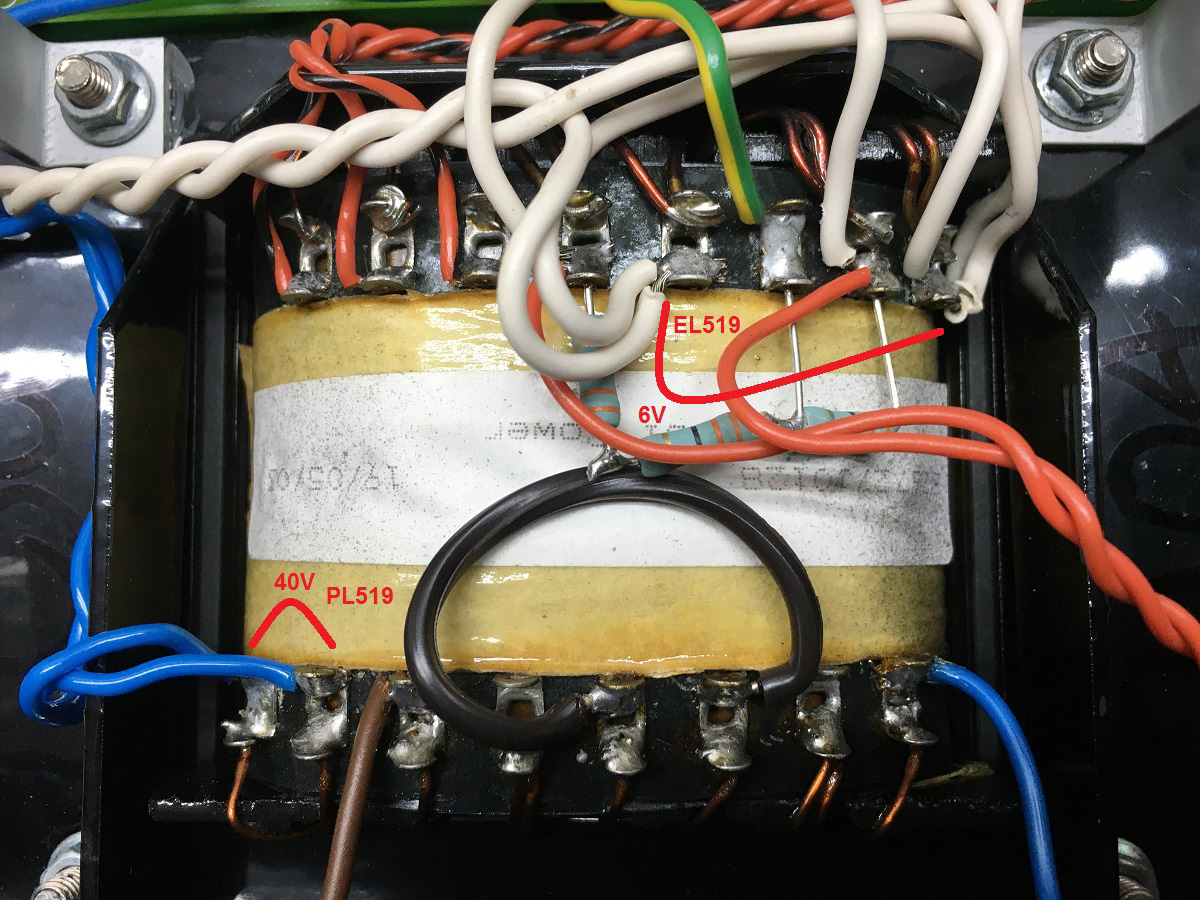
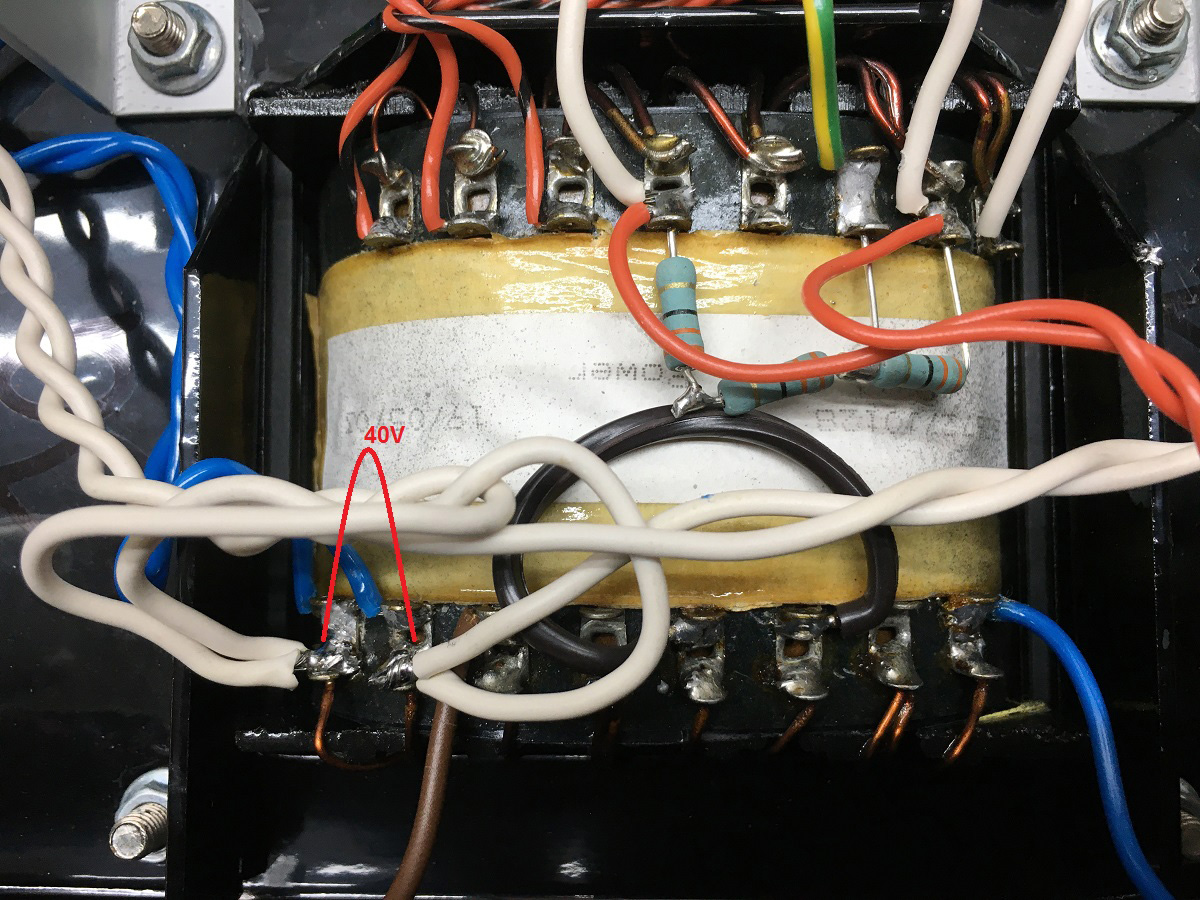
Wires from the two PL/EL-519 circuit boards to the mains transformer.
Move the twisted wires from 6.3 volts to 40 volts.
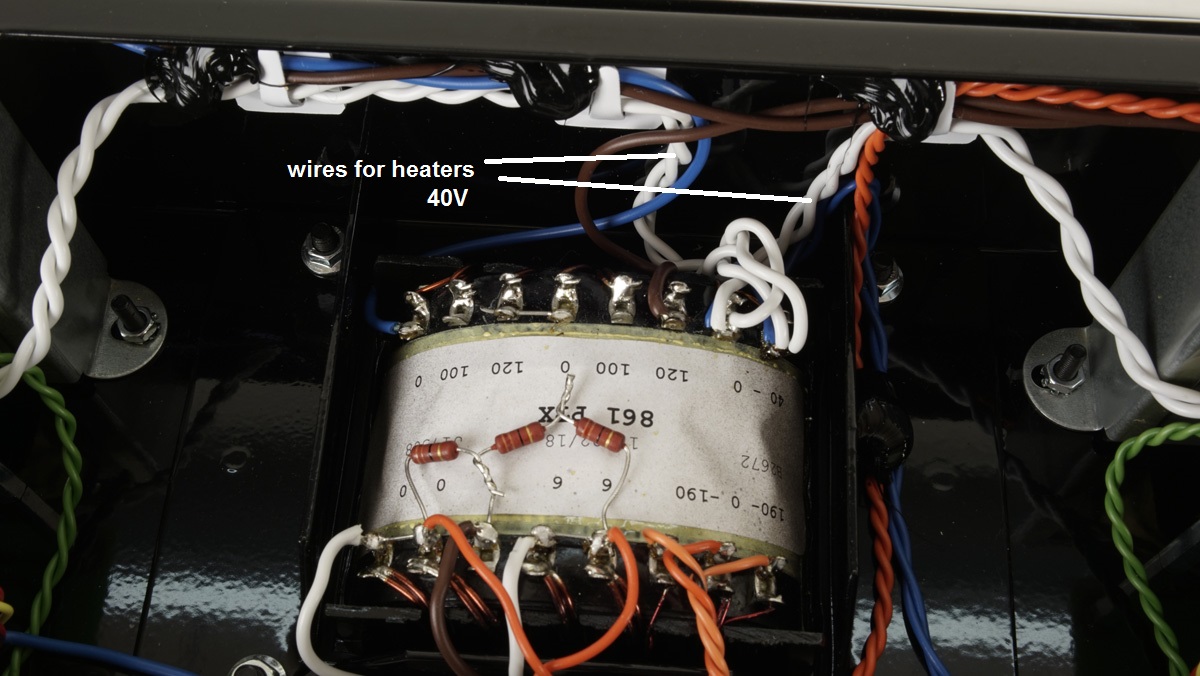
Image from my new -861s. Runs 40 volts for heaters.